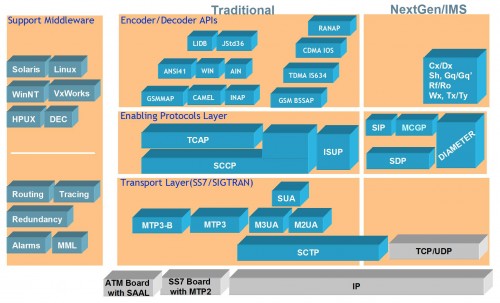Network application development platform enabling transport-independent deployment over converging wireless, IP and IN networks
The Diametriq Accelero™ Application Development Platform provides a versatile development environment for converging wireless, IP and intelligent network (IN) applications. Accelero simplifies building new network applications and services by insulating the application developer from the complexities of integrating third party components such as protocol stacks, application layer APIs and hardware interface cards. Accelero allows distributed applications to interoperate across disparate networks – despite differences in transport protocols, geographic location or network architecture. It empowers the application developer with a comprehensive solution suite to simplify the development process and reduce development time and cost. Accelero includes the necessary infrastructure components combining signaling protocols, encoders/decoders and OA&M software with development tools and a robust redundancy scheme.
Mature, Widely Deployed Signaling Protocol Stacks
The Accelero protocols have powered a rich feature set of more than fifty diverse telecom applications in more than sixty countries around the globe. Accelero has enabled high-performance applications and has carried signaling to support more than 100 million subscribers. The Accelero stack includes mature implementations of enabling protocols for transaction management (TCAP), signaling and address (SCCP), call processing (ISUP) and message transfer (MTP). The Accelero stack seamlessly integrates the IP signaling protocols for SIGTRAN.
Accelero™ APIs are:
- Easy to use C++ API’s that are modular and have an object-oriented implementation.
- Independent of the underlying stack configuration, such as ITU/ANSI/mixed.
- Flexible so you can bind more than one API suite, e.g. GSMMAP and CAMEL, at the same time.
- Hardware vendor and platform interoperable.
| TECHNICAL FEATURES | |
| Product Type | Software – Available in Linkable or Standalone Server Configuration |
| CPU Support | Single Processor/Multi Processor |
| Platforms supported | Linux (RedHat ES 4.0) – Solaris 10 – Windows XP, 2003 Server |
| Multithreading Support | Thread Safe |
| Software Redundancy | Fail over configuration [1+1], Link Sharing, Load Sharing [Active-Active] |
| OAM Configuration | XML – static data, API – programmer interface |
| Logging & Tracing | Dynamic levels of debug, File based logs/traces |
| Development Extension | C, C++ |
| Transport & Security | |
| Transport – SCTP (or TCP) | |
| Security – IPSec | |
| Interfaces | |
| Diameter | IETF RFC-3588 and 3GPP-IMS 3GPP TS 29.230 |
| 3GPP Cx/Dx, Sh, Rf/Ro/Rx, Gq, Tx/Ty and others | |
| GSMMAP | Phase 1, 2, 2+ and 3; Phase 2+ 3G TS 29 002 V3.4.0 (2000-3) |
| UMTS MAP | 3GPP TS 29.002 V4.2.1 (2000-12) |
| ANSI-41 | TIA/EIA-41.[1-6] D Dec 1997 |
| CAMEL | Stage 1 & 2 ETSI TS 101 046 (V7.0.0) 3rd Gen ETSI TS 129 078 (V3.3.0) (V5.0.0) |
| WIN | TIA/EIA/IS 771 July 1999 – TIA/EIA/IS 826 July 1999 – TIA/EIA/IS 848 July 1999 |
| SUPL | OMA SUPL 1.0 |
| RANAP | 3GPP TS 25.413 |
| INAP CS 1 | CS 1 ITU-T spec 1218 (release 10/95) |
| INAP CS 2 | CS 2 ITU-T Q1228 (09/97 release) |
| AIN 0.1, AIN 0.2 | TELCORDIA Generic Requirements AIN0.2 GR 1299 (Issue 4, 09/97) |
| LIDB | TELCORDIA Generic Requirements GR-95-4-CORE (Issue 2 March 1997) |
| SS7 Transport | |
| TCAP-ANSI | ANSIT1.114 1996 1992 |
| TCAP-ITU | Blue & White Book ITU-T Q.77x 06/97 |
| TCAP-China | TCAP China Specification based on ITU-T Q.77x 1997 |
| TCAP-Japan | TCAP Japan Specification based on ITU-T Q.77x 1997 |
| SCCP-ANSI | ANSI T1.112 1996 |
| SCCP-ITU | ITU-T Q.71X 07/96 ETSI ETS 300 009 |
| SCCP-China | SCCP China Specification based on ITU-T Q.71x 1996 |
| SCCP-Japan | SCCP Japan Specification based on ITU-T Q.71x 1996 |
| ISUP-ANSI | ANSI T1.113 – 1995, |
| ISUP-ITU | ITU-TQ.76X 09/97 |
| SIGTRAN Transport | |
| SUA | IETF Draft 14 July 2002 |
| M3UA | IETF RFC 3332 September 2002 |
| SCTP | IETF RFC 2960, October 2000 |
| ATM Transport | |
| MTP3-B | White Book ITU Q.70x. 7/96 ANSI T1.1.11 1996 |






